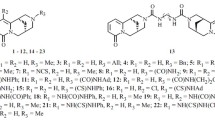Summary
The present study tested the hypothesis that the experimental antineoplastic imidazotetrazinone temozolomide degrades in the biophase to 3-methyl-(triazen-1-yl)imidazole-4-carboxamide (MTIC) and exerts its cytotoxicity via this species. MTIC is a metabolite of the antimelanoma agent dacarbazine and is thought to be responsible for the antineoplastic activity of the latter. Cytotoxicity in vitro was investigated in TLX5 murine lymphoma cells. MTIC and temozolomide were cytotoxic in the absence of mouse-liver microsomes, whereas dacarbazine required metabolic activation. The generation of MTIC from either dacarbazine, its primary metabolite 5-[3-(hydroxymethyl)-3-methyl-triazen-1-yl]-imidazole-4-carboxamide (HMMTIC) or temozolomide was studied by reversedphase high-performance liquid chromatography in incubation mixtures under the conditions of the cytotoxicity assay. MTIC was found in incubations of temozolomide with or without microsomes. Dacarbazine yielded MTIC (and HMMTIC) only when microsomes were included in the incubation mixture. Although the mode of action of temozolomide seems to be similar to that of dacarbazine, the results obtained in this study show that these agents differ markedly in their ability to generate the active species MTIC.
Similar content being viewed by others
Abbreviations
- AUC:
-
area under the curve
- HMMTIC:
-
5-[3-(hydroxymethyl)-3-methyl-triazen-1-yl]imidazole-4-carboxamide
- HPLC:
-
highperformance liquid chromatography
- MTIC:
-
3-methyl-(triazen-1-yl)imidazole-4-carboxamide
References
Baig GU, Stevens MFG (1987) Antineoplastic imidazotetrazines: 12. Reaction of mitozolomide and its 3-alkyl congeners with oxygen, nitrogen, halogen and carbon nucleophiles. J Chem Soc Perkin Trans I 48: 3389
Bill CA, Gescher A, Hickman JA (1988) Effects ofN-methylformamide on the growth, cell cycle, and glutathione status of murine TLX5 lymphoma cells. Cancer Res 48: 3389
Boyle W (1968) An extension of the51Cr release assay for the estimation of mouse cytotoxins. Transplantation 6: 761
Connors TA, Goddard PM, Merai K, Ross WCJ, Wilman DEV (1976) Tumour inhibitory triazenes. Structural requrements for an active metabolite. Biochem Pharmacol 25: 241
Gescher A, Thradgill MD (1987) The metabolism of triazene antitumor drugs. Pharmacol Ther 32:191
Horspool KR, Quarterman CP, Slack JA, Gescher A, Stevens MFG, Lunt E (1989) Metabolism and murine pharmacokinetics of the 8-(N, N-dimethylcarboxamide) analogue of the experimental antitumor drug mitozolomide (NSC353451). Cancer Res 49: 5023
Kolar GF, Maurer M, Wildschütte M (1980) 5-(3-Hydroxymethyl)-3-methyl-triazeno-imidazole-4-carboxamide is a metabolite of 5-(3,3-dimethyl-1-triazeno)imidazole-4-carboxamide (DIC, dacarbazine, NSC-45388). Cancer Lett 10:235
Rutty CJ (1983) The species-dependent pharmacokinetics of dacarbazine. Br J Cancer 48:140
Shealey YF, Struck RF, Holum LB, Montgomery JA (1961) Synthesis of potential antitumor agents: XXIX. 5-Diazoimidazole-4-carboxamide and 5-diazo-v-triazole-4-carboxamide. J Org Chem 26: 2396
Shealey YF, Krauth CA, Montgomery JA (1962) Imidazoles: I. Coupling reactions of diazoimidazole-4-carboxamide. J Org Chem 27:2150
Slack JA, Goddard C, Stevens MFG, Baig GU, Griffin MJ (1986) Analysis and murine pharmacokinetics of the new antitumour agent CCRG 81 045. J Pharm Pharmacol 38:63
Stevens MFG, Hickman JA, Stone R, Gibson NW, Baig GU, Lunt E, Newton CG (1984) Antineoplastic imidazotetrazines: 1. Synthesis and chemistry of 8-carbamoyl-3-(2-chloroethyl)-imidazo-[5,l-d]-1,2,3,5-tetrazin-4(3H)one-a novel broad spectrum antitumor agent. J Med Chem 27:196
Stevens MFG, Hickman JA, Langdon SP, Chubb D, Vickers L, Stone R, Baig G, Goddard C, Gibson NW, Slack JA, Newton C, Lunt E, Fizames C, Lavelle F (1987) Antitumor activity and pharmacokinetics in mice of 8-carbamoyl-3-methyl-imidazo[5, l-d]-1,2,3,5-tetrazin-4(3H)-one (CCRG 81045; M&B 39831), a novel drug with potential as an alternative to dacarbazine. Cancer Res 47:5846
Tisdale MJ (1985) Induction of haemoglobin synthesis in the human leukaemia cell line K562 by monomethyl triazenes and imidazotetrazinones. Biochem Pharmacol 34:2077
Tsang LH, Farmer PB, Gescher A, Slack JA (1990) Characterisation of urinary metabolites of temozolomide in humans and mice and evaluation of their cytotoxicity. Cancer Chemother Pharmacol (in press)
Vaughan K, Stevens MFG (1978) Monoalkyltriazenes. Chem Soc Rev 7:277
Author information
Authors and Affiliations
Additional information
Part XXIII in the series: Antitumour imidazotetrazines (for part XXII, See Tsang et al. [15]
Rights and permissions
About this article
Cite this article
Tsang, L.L.H., Quarterman, C.P., Gescher, A. et al. Comparison of the cytotoxicity in vitro of temozolomide and dacarbazine, prodrugs of 3-methyl-(triazen-1-yl)imidazole-4-carboxamide. Cancer Chemother. Pharmacol. 27, 342–346 (1991). https://doi.org/10.1007/BF00688855
Received:
Accepted:
Issue Date:
DOI: https://doi.org/10.1007/BF00688855




